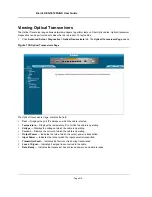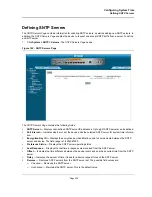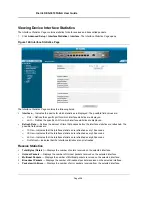
Configuring System Time
Configuring SNTP
Page 217
Configuring SNTP
The device supports the Simple Network Time Protocol (SNTP). SNTP assures accurate network device clock
time synchronization up to the millisecond. Time synchronization is performed by a network SNTP server. The
device operates only as an SNTP client, and cannot provide time services to other systems. The device can poll
the following server types for the server time:
•
Unicast
•
Anycast
•
Broadcast
Time sources are established by stratums. Stratums define the accuracy of the reference clock. The higher the
stratum (where zero is the highest), the more accurate the clock. The device receives time from stratum 1 and
above.
The following is an example of stratums:
•
Stratum 0
— A real time clock (such as a GPS system) is used as the time source.
•
Stratum 1
— A server that is directly linked to a Stratum 0 time source is used. Stratum 1 time servers pro-
vide primary network time standards.
•
Stratum 2
— The time source is distanced from the Stratum 1 server over a network path. For example, a
Stratum 2 server receives the time over a network link, via NTP, from a Stratum 1 server.
Information received from SNTP servers is evaluated based on the Time level and server type. SNTP time defini-
tions are assessed and determined by the following time levels:
•
T1
— The time at which the original request was sent by the client.
•
T2
— The time at which the original request was received by the server.
•
T3
— The time at which the server sent the client a reply.
•
T4
— The time at which the client received the server's reply.
Polling for Unicast Time Information
Polling for Unicast information is used for polling a server for which the IP address is known. T1 - T4 are used to
determine the server time. This is the preferred method for synchronizing device time.
Polling for Anycast Time Information
Polling for Anycast information is used when the server IP address is unknown. The first Anycast server to return
a response is used to set the time value. Time levels T3 and T4 are used to determine the server time. Using Any-
cast time information for synchronizing device time is preferred to using Broadcast time information.
Broadcast Time Information
Broadcast information is used when the server IP address is unknown. When a broadcast message is sent from
an SNTP server, the SNTP client listens for the response. The SNTP client neither sends time information
requests nor receives responses from the Broadcast server.
Message Digest 5 (MD5) Authentication safeguards device synchronization paths to SNTP servers. MD5 is an
algorithm that produces a 128-bit hash. MD5 is a variation of MD4, and increases MD4 security. MD5 verifies the
integrity of the communication, authenticates the origin of the communication.
Summary of Contents for DES-3010FA
Page 1: ......
Page 10: ...D Link DES 3010FA GA Installation Guide Page 9 D Link DES 3010FA GA Installation Guide...
Page 49: ...D Link DES 3010FA GA User Guide Page 48 D Link DES 3010FA GA EWS User Guide...
Page 251: ...D Link DES 3010FA GA User Guide Page 250...
Page 252: ...Contacting D Link Technical Support Page 251...
Page 253: ...D Link DES 3010FA GA User Guide Page 252...
Page 254: ...Contacting D Link Technical Support Page 253...
Page 255: ...D Link DES 3010FA GA User Guide Page 254...
Page 256: ...Contacting D Link Technical Support Page 255...
Page 257: ...D Link DES 3010FA GA User Guide Page 256...
Page 258: ...Contacting D Link Technical Support Page 257...
Page 259: ...D Link DES 3010FA GA User Guide Page 258...
Page 260: ...Contacting D Link Technical Support Page 259...
Page 261: ...D Link DES 3010FA GA User Guide Page 260...
Page 262: ...Contacting D Link Technical Support Page 261...
Page 263: ...D Link DES 3010FA GA User Guide Page 262...
Page 264: ...Contacting D Link Technical Support Page 263...
Page 265: ...D Link DES 3010FA GA User Guide Page 264...
Page 266: ...Contacting D Link Technical Support Page 265...
Page 267: ...D Link DES 3010FA GA User Guide Page 266...
Page 268: ...Contacting D Link Technical Support Page 267...
Page 269: ...D Link DES 3010FA GA User Guide Page 268...
Page 270: ...Contacting D Link Technical Support Page 269...
Page 271: ...D Link DES 3010FA GA User Guide Page 270...
Page 272: ...Contacting D Link Technical Support Page 271...
Page 273: ...D Link DES 3010FA GA User Guide Page 272...
Page 274: ...Contacting D Link Technical Support Page 273...
Page 275: ...D Link DES 3010FA GA User Guide Page 274...
Page 276: ...Contacting D Link Technical Support Page 275...
















































